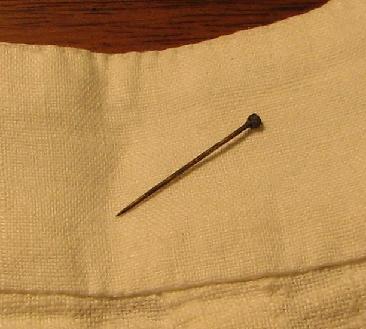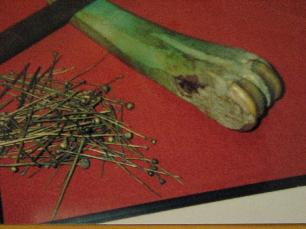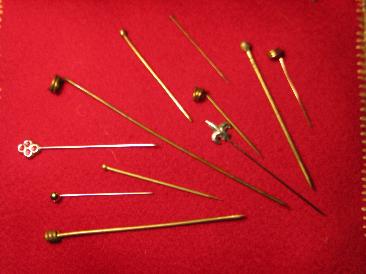This article originally appeared in the October 1999 issue of the Fencers, Dancers and Bearbaiters Quarterly.
|
|
Elizabethan Fastenings: Pins
|
 |
| a 16th century pin (collection of the author) |
|
Considering the scant current mention of pins in costume and clothing articles, it may be hard to believe how common these simple items were to the wardrobes of the Elizabethans. They were made in many sizes, from the "great verthingale pynnes" used to hold heavy skirts, to the smallest pins used to hold veils and delicate fabrics. Janet Arnold documents the pin purchases for Queen Elizabeth in a six-month period:
"Item to Roberts Careles our Pynner for xviij [18] thousand great verthingale Pynnes xx [20] thowsand great Velvet Pynnes and nyne thowsande smale hed Pynnes and xix [19] thowsand Small hed Pynnes all of our great warderobe" (Warrant dated 20 Oct, 1565)
While the number of pins for the Royal household seems extraordinary, considering the elaborate clothing effects required by the Queen and her attendants, one wonders that she didn't need more.
Pins were used to hold skirt flounces, farthingale boning, ruffs, cuffs, partlets, veils, jewels, and generally everything that needed to stay in place. They were carefully kept, and straightened and sharpened periodically. Pins were not left in clothing (oxidation of the metal will stain the fabric, and if moved carelessly, the pins could also rip the fabric), but stored in pincushions.
The well-known portrait of the Countess of Southampton shows her at her dressing table, upon which sits a large pin cushion stuffed with round-headed pins. The bag and pincushion sets in the Victoria and Albert Museum in London suggest that pins were also carried on the person to effect emergency alterations, and given as gifts.
|
 |
| pins and pin bone from the Museum of London |
|
The pins on display in public and private collections that date from the 16th century are identical to the pins in the Southampton portrait, round-headed and ranging in size from a hefty 4" to tiny 1/2" pins suitable for delicate silks. They are constructed with a drawn wire shank and a separately made then attached ball head made from wrapped wire that is then melted and welded to the shank. There is no consistency to the head sizes, but the smaller pins generally have smaller heads. The pin display in the Museum of London that dates from the previous century includes the leg bone of a cow cut in half and grooved on the cut end to hold a pin for sharpening. The 16th century pin makers used the same method; finds from the wreck of the Mary Rose have identified a pin sharpening bone and numerous pins.
|
While steel pins existed, brass pins were a lot more common (brass is easier to make and work than steel). A warrant for 1563 gives the prices for different kinds of pins:
"Item to Robert Careles the pynner for xvjm [16000] great verthingale pynnes at vj s [six shillings] the m [per 1,000] ...lviij m [58,000] small velvet and hed pynnes at xx d [20 pence] m [per 1,000]."
While Elizabeth and her Court clearly used vast quantities of pins, the lower classes would not have need quite so many to keep their simpler clothes in place, and a handful of pins would suffice to dress a working woman. In terms of the modern-day re-enactor, a small pincushion will usually be sufficient for all but the most elaborate of outfits.
|
 |
| reproduction pins from various sources |
|
From personal experience, I find that straight pins work even better than safety pins for holding clothes in place. I have used pins to stop shoulder straps from slipping, to keep cuffs and falling bands in place, to attach jewelry, close gaps, and to hold aprons in place. Every person interested in an authentic appearance should be using straight pins.
Note: When I originally wrote this article, brass pins were hard to find, and the members of Gardiner's company usually made their own from hobby store wire, twisting the ends into round coils. Since then, several shops that specialize in period accessories have started selling good-quality brass pins.
|
|